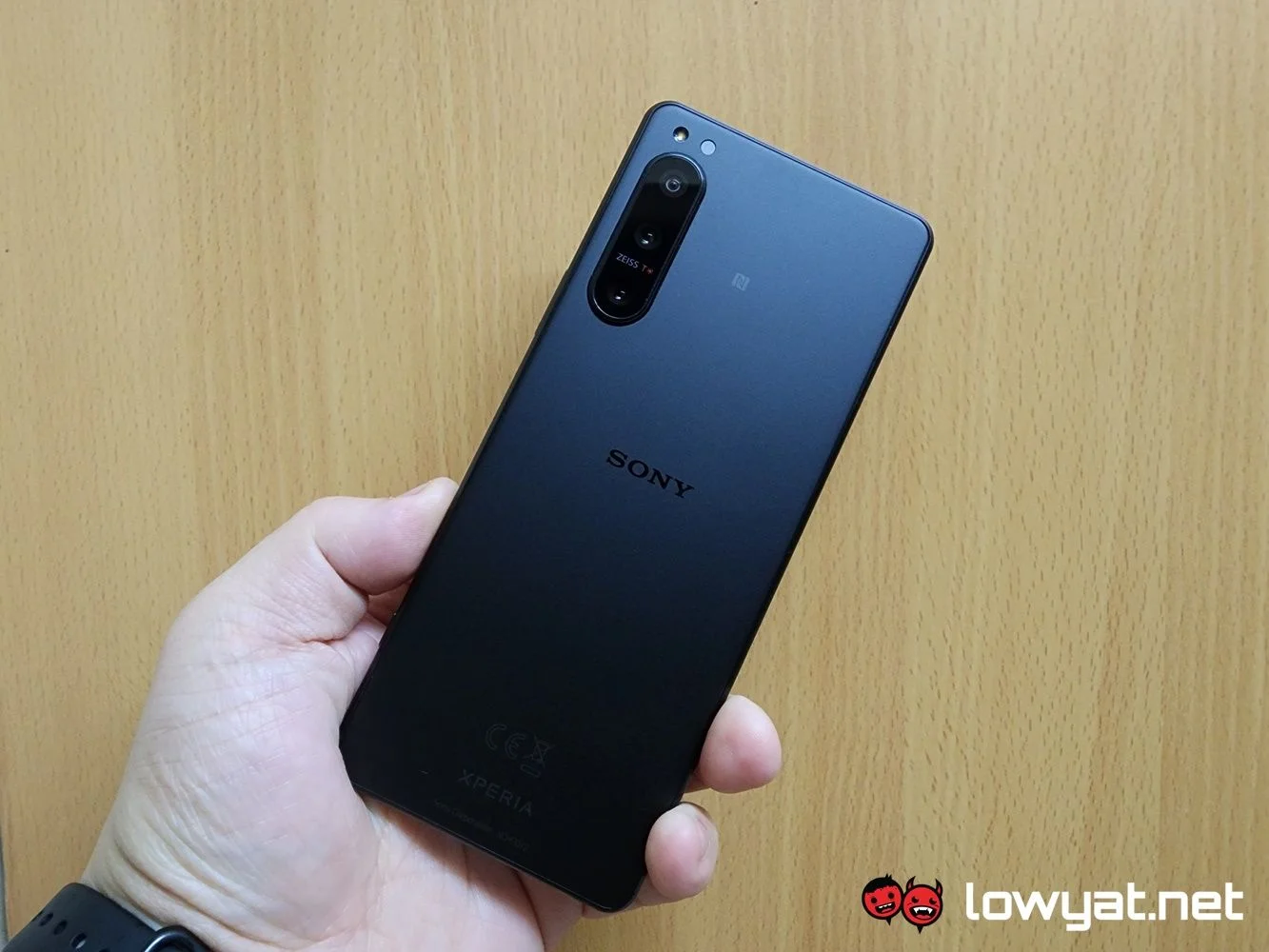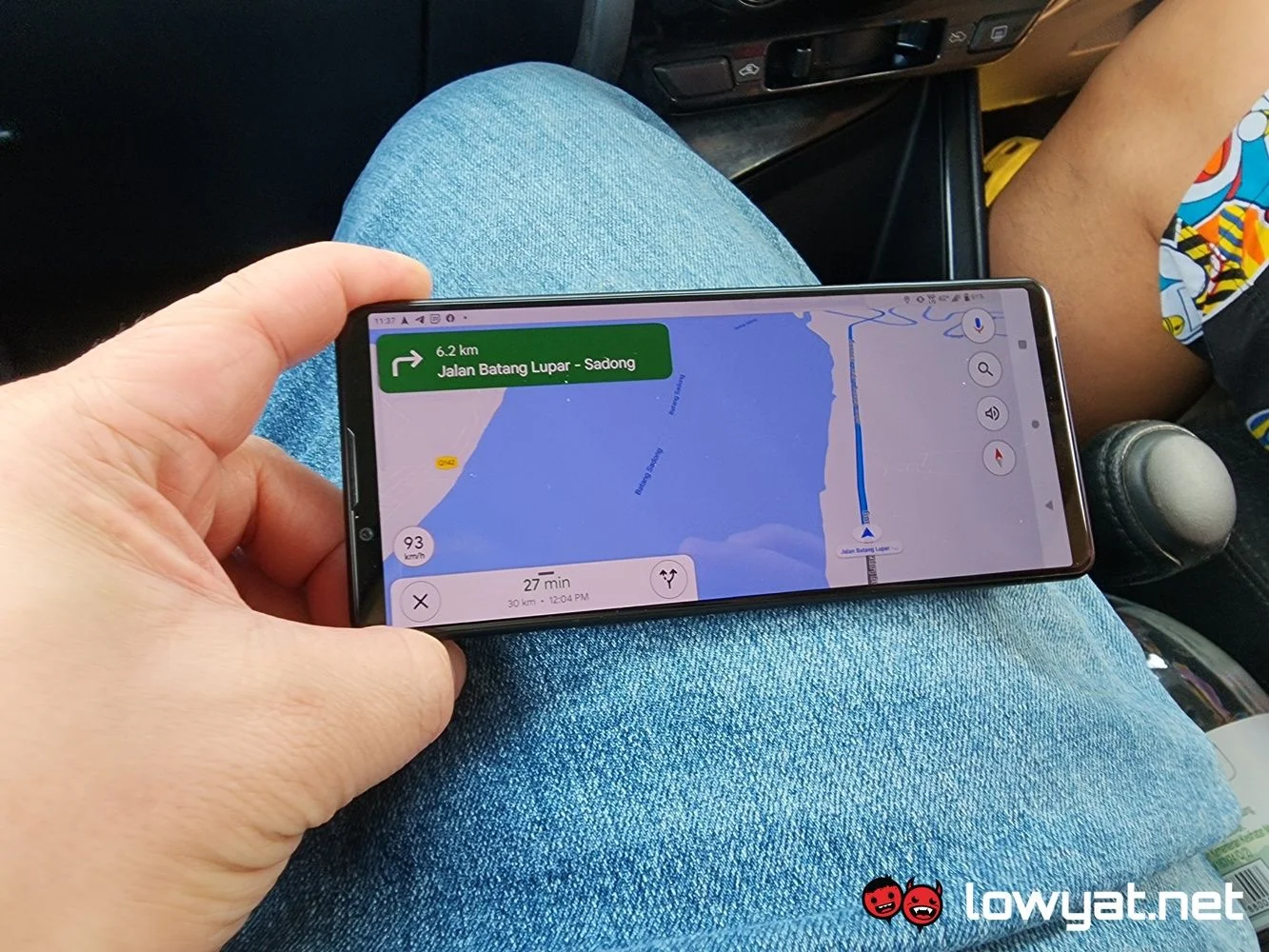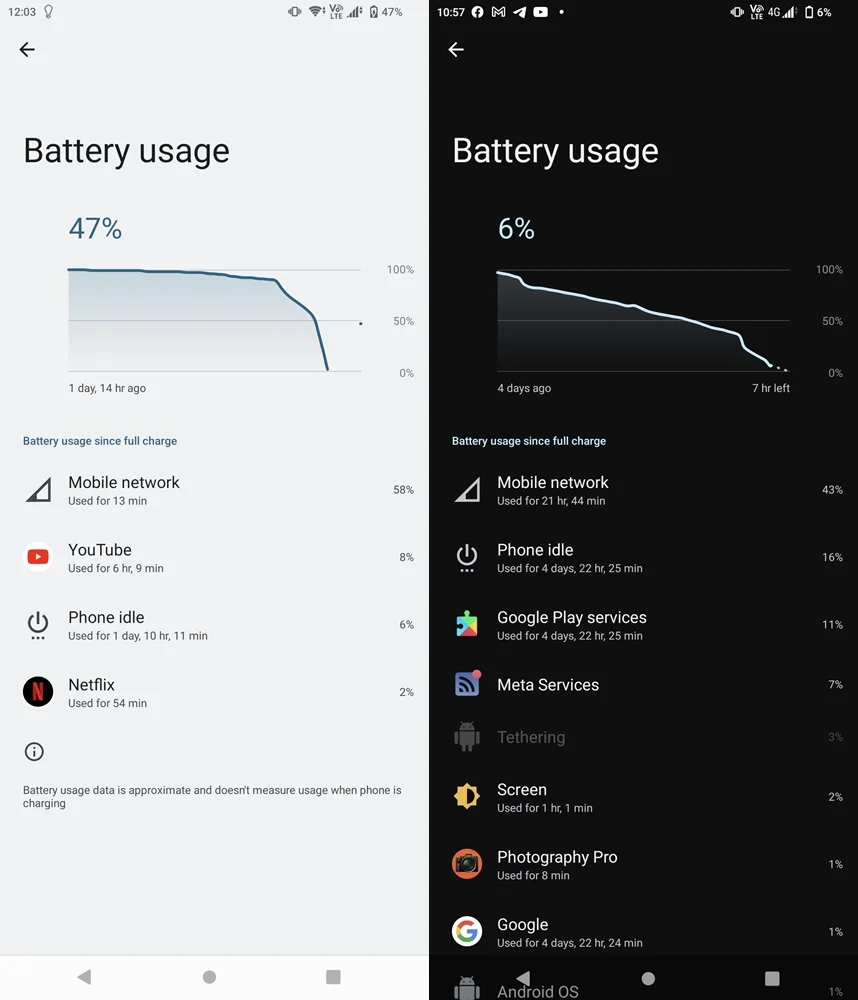While many among us widely believe that the Xperia 5 IV is a watered down version of the bigger and more premium Xperia 1 IV, I am here to say that that isn’t necessarily the case, especially with what is on offer with this phone.
Specification
Design
The Xperia 5 IV sports the same long, slim all-black chassis and design language as the bigger Xperia 1 IV, albeit being obviously smaller in size. However, unlike its direct predecessors in the lineup, Sony has ditched the rounded sides, edges, and corners for the more premium feeling CNC-milled aesthetic of the 1 IV. Trust me, it actually feels as good as it actually looks.
Sony has carried the chassis design of the Xperia 1 IV over to the compact form factor.
Speaking of the feel of the phone, the compact form factor of the Xperia 5 IV is just as comfortable as, once again, it’s predecessors. I love that I am able to wield, and manage this phone with just one hand, and even better, I am not giving my left thumb carpal tunnel by trying to extend it beyond the muscles in it are able to do. That too, is also alleviated by the phone’s slimmer and longer-than-average body and display. Sure, I know some of you may not have enjoyed Sony’s decision to go ahead with the 21:9 aspect ratio implementation with the Xperia 5 IV, or this current reboot of the Xperia series. For this writer, I actually don’t mind it at all, black bars and all.
Speaking of which, the display of the Xperia 5 IV is only Full HD+ but it is also an OLED panel with a maximum refresh rate of 120Hz. Flip the phone around to the back, and you’re greeted with a plain and unassuming matte black rear, with the bare minimum of markings: the Xperia branding on the lower half, and the NFC mark to indicate where the feature is located on the phone. You’ll also find the main camera housing of the Xperia 5 IV located in the top left corner of its back. That camera housing, by the way, housing a triple 12MP setup with wide, ultra wide, and “telephoto” functions, although the latter is limited by maximum zoom length of just 2.5x, or 72mm. As for the selfie camera, you’re looking at another 12MP sensor.
Side-mounted fingerprint scanner is, in my opinion, still a very practical version of physical verification.
Other physical features of the Xperia 5 IV are actually what I have come to expect of the brand – there’s the side-mounted fingerprint scanner that has become synonymous with Sony’s devices, along with a dedicated shutter button that sadly, isn’t ridged like the Pro-I which I reviewed some time ago. But that is an extremely minor setback and one that really doesn’t detract from the phone’s overall experience. As per the standard, there’s a USB-C port at the base of the Xperia 5 IV that supports 30W PD fast charging, provided you have the appropriate adapter for it. I mention this because as of this generation, Sony no longer provides the wall charger and cable in its packaging. Also, the SIM card tray is also installed here, and mercifully, it supports hot-swapping.
Above all else, the one thing that the Xperia 5 IV still manages to retain is something other smartphone brands have done away with: the 3.5mm headphone jack. The one factor that really stings about the Xperia 5 IV? Its asking price. While Sony is only bringing in the version with 256GB, a single unit retails for a wallet-puncturing RM4899.
User Experience
As an Xperia device, the Xperia 5 IV is everything you expect of the brand: a powerful yet simply designed mobile device, masked in the colour of opulence. And before you get the wrong idea, allow me to say that that isn’t necessarily a bad thing.
The compact experience is very much alive with this phone.
The compact and smaller chassis of the Xperia 5 IV is, in my opinion, one of the charms of the phone, especially when you consider that Sony is, in true Japanese spirit, the only smartphone maker that defiantly continues making such compact devices. Honestly, I have missed being able to open my phone and check my messages single-handed, literally. On the subject of unlocking the phone, I am also appreciative of the fact that Sony retains the side-mounted fingerprint scanner cum power button – while the world has since moved to facial recognition and in-display fingerprint scanners, this is still one of the most ideal forms of identity recognition.
Moving on, the viewing experience on an OLED display is still both pleasant and eye-popping, even more so since Sony doesn’t overdo it with its colour accuracy on the Xperia 5 IV. Colours are vibrant, blacks are deep and not grey, and the whites are neutral, looking neither warmer nor cooler than the displays of Sony’s rivals. I won’t go into too much detail regarding the performance of the Xperia 5 IV – Like the 1 IV, it’s rocking the same Snapdragon 8 Gen1 SoC and if you’ve read our reviews of all the other flagship smartphones fitted with the same chipset, you know that it’s no slouch. Right out of the box, the phone boots up in seconds, apps load instantaneously and shut down just as fast, and switching between tabs are effortless.
Xperia UI is still the closest to vanilla Android UI.
As is the norm with Sony’s lineup, and as most loyal Sony fans will tell you the Xperia UI is still the closest overlay you can get to a near-vanilla Android UI experience. It’s clean, it’s still virtually uncluttered when compared to the UIs of other brands, and credit to Sony, the brand does release software updates frequently. As for the viewing experience, the OLED display of the Xperia 5 IV is gorgeous as one would expect. Every show I watch on the phone really comes to life, with colours just being deep, rich, and ever so accurate on the display. Despite its narrower body, typing on the Xperia 5 IV isn’t as difficult as I anticipated, nor is it a chore. In fact, I actually typed this portion and several other portions of the review out on the phone, one-handed and without the Swiftkey motions. Really, it is a comfortable affair.
Another point that I have noticed about the Xperia 5 IV is that, compared to the 1 IV, the phone is not as quick to heat up when put to task. In long periods of usage such as binge watching shows on YouTube or Netflix, the phone gets just warm enough without burning my hands. In fact, the only time the Xperia 5 IV turns up the heat, and rapidly at that, is when I start recording 4K video via Videography Pro, and all it takes is 15 minutes of continuous recording. Again, that is to be expected of the device capable of recording those resolutions.
As for battery life, the legs that this Xperia 5 IV have are really, really long. On a day-to-day basis, the phone holds out for an average of two days with the occasional videos, emails, and social media consumption, and double that if I leave the phone idle. On a full-on binge, the phone eats through the 5000mAh battery in a little over six hours, which isn’t bad but given that I have reviewed smartphones with better and stronger battery life, it does feel a little bit of a letdown.
Camera
As with all smartphones in the market, the inevitable selling point of the Xperia 5 IV, or at the very least, what Sony wants it to be, is the photography capabilities of the phone’s triple 12MP main module. The choice of the sensor has been a staple for both the 1s and 5s of this generation from where I’m sitting, it’s probably because Sony is trying to enhance and improve upon the Zeiss-flanked imaging component. Unlike its bigger brother, the Xperia 1 IV, the Xperia 5 IV lacks the 85mm to 125mm continuous optical zoom function. To be clear, an optical zoom function is still present, but that has been cut down to just 60mm and anything beyond that focal length begins relying on digital zoom functionality. The final result of the Xperia 5 IV, at least in terms of day-to-day photography, is what I have come to expect of a phone from this brand. Pictures I take, especially during the day, look sharp, retain a lot of detail, while still looking naturally vibrant color-wise, and are less punchy than what Samsung’s flagship series smartphones usually do. For another matter, the image post-processing of Xperia 5 IV is definitely one of the more practical applications of the feature that I’ve seen done with a smartphone. As I said, Sony tends to veer towards maintaining more natural colours in their images, and with this phone, there is no continuous optical zoom function. To compensate, the main camera is able to pull off some rather impressive bokeh effects around whatever my focus or subject is. Seriously, it is actually decent enough that, unlike Samsung’s cameras, said bokeh effect doesn’t actually look like it is leaking from the sides or even warped.
Where the Xperia 5 IV surprises me and to an even greater extent, outperforms the Xperia 1 IV, is when I use it for nighttime and low-light photography. When I reviewed the 1 IV, I stated that the final images captured were hit-or-miss and for some images, they looked absolutely smudged. In the case of the 5 IV, virtually all nightshots I have taken seem to have the opposite effect. Not only are they able to maintain a high level of detail, they also do not look washed out. One of my favourite shots was that of a close-up of a firework, of which I am able to see every spark it makes, along with the source of the pyromania.
On another note, the Xperia 5 IV also doesn’t heat up as fast or as aggressively as other smartphones, especially when I am using the camera for either taking pictures or recording short videos. With regard to the latter, you will actually need to open up the Videography Pro app manually, if you plan on capturing videos at 4K resolution with the Xperia 5 IV.
Sample Images
Nightshots
Competition
While I have often argued that the Xperia 5 lineup is the template on which compact smartphones in the last decade should be based on, the Xperia 5 IV is far from the only phone with the “compact” designation. Below are a couple of contenders that truly give the device a run for its money.
Apple iPhone 14
It should come as no surprise that if you’re looking for a “compact” alternative to the Xperia 5 IV, the iPhone 14 definitely makes the list. Armed with a 6.1-inch Super Retina XDR OLED display, the phone is powered by the fruit brand’s own A15 Bionic SoC, 6GB RAM, and comes with internal storage capacities of 128GB, 256GB, and 512GB. However, the iPhone 14 only has a dual main camera setup, with both sensors being 12MP f/1.5 but are bigger at 1.9μm pixels. while the selfie camera is also a 12MP f/1.9 sensor. Keeping all the components powered is a 3279mAh battery. Lastly, the phone retails from RM4199 for the 128GB, RM4699 for the 256GB model, and RM5699 for the 512GB version.
Samsung Galaxy S23
[Image: Samsung.]Launched at the start of the month, the Samsung Galaxy S23 Series is the Korean brand’s latest generation of flagship smartphones, with the S23 being the base model of the trio and the direct competitor to the Xperia 5 IV. Beneath the hood, the phone’s chipset is more up-to-date, sporting Qualcomm’s latest Snapdragon 8 Gen2 SoC, 8GB RAM, and between 128GB and 256GB internal storage capacity. Other specifications of the S23 include a smaller 3900mAh battery, a 6.1-inch FHD+ Dynamic AMOLED 2X 120Hz Corning Gorilla Glass Victus 2 display, and an IP68 rating. It also has a beefier main triple camera array, comprising a 50MP f/1.8 wide, a 12MP f/2.2 ultrawide, and a 10MP f/2.4 telephoto with 3x optical zoom. Oh, and there’s also a 12MP f/2.2 selfie camera. It’s also cheaper than the Xperia 5 IV, coming in at a starting SRP of RM3899 for the 128GB model and RM4199 for the 256GB version.
Conclusion
While I would say that the Xperia 5 IV, like its bigger brother, is a year-on-year update over the last generation, the updates that have been given to this phone’s camera capabilities are, interestingly, significant.
The Sony Xperia 5 IV and its main camera are surprisingly serviceable.
Once again, while the Xperia 5 IV lacks the ability to perform continuous zoom like the bigger 1 IV, the way the phone tastefully applies the bokeh effect to each and every picture is impressive and perhaps one of the better implementations on a Snapdragon 8 Gen1-powered device that I have personally used, to-date. Of course, it also helps that the phone isn’t a slouch, by any measure of the definition. Having said that, I do find it a little hard to justify the asking price of RM4899, especially since, as you can see in the competition section, there are other devices in its class that offer more in terms of real-world and day-to-day features, including digital wallets, such as Samsung Pay or Wallet, or Apple Pay. Is the Xperia 5 IV a lot of fun? Not necessarily. But, if you’re looking for a compact shooter that is capable of capturing pictures in low-light situations with just a moderate amount of post-processing, this could be the phone for you. Photography by John Law.















